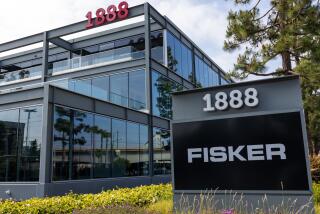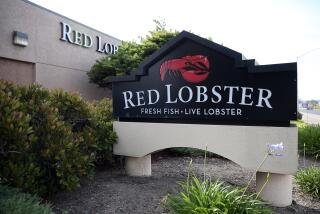Sizzler Could Use a Little Grilling
- Share via
Big institutional investors often are accused of badgering corporate managers to boost their companies’ share prices.
But sometimes it seems as if those investors don’t badger enough. Sizzler International Inc., the Los Angeles-based owner of the Sizzler restaurant chain, looks like a case in point.
Sizzler has been floundering for three years, its stock price tumbling ever lower as the company’s flagship U.S. chain suffered an identity crisis that sharply eroded its earnings and its customer base.
On Tuesday, the company dropped yet another bomb, saying it lost about $4 million in the quarter ended Feb. 4 because of slower sales, bad weather and higher costs. As a result, Sizzler said it is in technical default on its bank loan agreements.
The bank default is likely to stay technical, not actual. Although Sizzler clearly needs to generate more cash quickly, it has relatively little long-term debt and annual sales in excess of $400 million, and doesn’t appear to be in any danger of bankruptcy.
Still, Tuesday’s news must have spooked smaller shareholders: The stock dove 62.5 cents to a record low close of $2.75 on the New York Stock Exchange.
The saddest thing about Tuesday’s stock-price action is that those sellers may have dumped at the bottom. At $2.75 a share, the stock now sells for less than half its book value (the net value of the company’s assets).
Although the company’s U.S. operation of about 470 Sizzler restaurants in 26 states has been a dog, Sizzler also owns a profitable and expanding restaurant business in Asia, now accounting for 40% of total sales.
By some analysts’ estimates, Sizzler’s current paltry $76-million market value--the total worth of its stock--is about what the Asian franchise alone is worth. That means the market may be placing no value at all on the U.S. Sizzler franchise.
The upshot is that if management and/or the company’s major shareholders ever needed motivation to “realize shareholder value,” as the over-used phrase goes, they have it now. That’s no guarantee that anything will happen soon, of course, but Sizzler does seem to be at a significant crossroad:
* The company’s ailing domestic Sizzler restaurant chain, concentrated in California, is aiming for a concept make-over that could get people walking in the door again. Finally moving away from the money-losing salad bar image, management wants to reemphasize grill foods and has been testing a new menu and a new look that would re-christen the stores “Sizzler American Grill.”
The company said Tuesday that the pilot remake of its 13 Phoenix-area restaurants into Sizzler American Grills--at a cost of under $100,000 per site--”generated sales increases in excess of 15% through its first 19 weeks.”
Since October the U.S. business has been run by Tim Ryan, who previously helped reposition such chains as Taco Bell and the Olive Garden.
* Sizzler Chairman James A. Collins, now 68, owns 13.7% of the company’s stock and thus has been watching his primary asset melt away, with the share price now below $3. “He is very motivated to get the stock price up,” contends one money manager who knows the company well.
* The company’s major shareholders include Los Angeles-based Capital Group (which owns more than 8%) and the State of Wisconsin pension fund (10.3%), both savvy institutional holders that may be unlikely to stand idly by if the company fails to turn its fortunes around soon. Neither Capital nor Wisconsin would comment Tuesday.
But Wisconsin was fed up enough a year ago to demand that Sizzler allow shareholders to vote on the company’s anti-takeover “poison pill” plan. The company acceded to a nonbinding referendum.
Oddly enough, however, the pill was upheld by the majority of shareholders.
Indeed, it’s peculiar that more shareholders haven’t tried to push Sizzler sooner toward resolving its problems and restoring growth.
The company’s basic U.S. restaurant concept has been failing since 1992. By positioning itself as an “all-you-can-eat” food/salad bar chain, “they were shooting for the top line [sales] but shot themselves in the bottom line,” says Hal Sieling, a restaurant industry consultant in Carlsbad.
The company also suffered some bad luck: California’s economic depression, and the bacterial poisoning of some patrons in Oregon in 1993.
Yet why did it take so long for Sizzler to realize that its food/salad bar concept wasn’t working, and that a remake was overdue? Christopher R. Thomas, Sizzler’s finance chief, insists that “we’ve been working on the [make-over] for some time.” He notes that the firm began to take restructuring steps in 1993, closing dozens of underperforming restaurants. But it waited until last December to get serious about slashing corporate costs.
Still, all the while the company’s Asian operation--nearly 130 Sizzlers in nine countries (mostly in Australia) and 92 Kentucky Fried Chicken franchises in Australia--has been consistently profitable, and expanding.
What the stock market now is saying is that Sizzler’s only real value is in its Asian business. Maybe the market is right, and Sizzler’s U.S. franchise simply can’t be turned around, especially given the intensely competitive family restaurant business. The make-over plan’s success is far from assured, and it will cost money upfront. But if the chain can be revived, the stock is almost certainly worth more than $2.75 a share. As a speculative bet, this one has more appeal than many.
(BEGIN TEXT OF INFOBOX / INFOGRAPHIC)
Starving Investors
Sizzler International Inc. shares have been in a steady decline since 1991, and on Tuesday the stock closed at a record low of $2.75. High prices each quarter on the NYSE and latest:
Tuesday: $2.75
More to Read
Inside the business of entertainment
The Wide Shot brings you news, analysis and insights on everything from streaming wars to production — and what it all means for the future.
You may occasionally receive promotional content from the Los Angeles Times.









